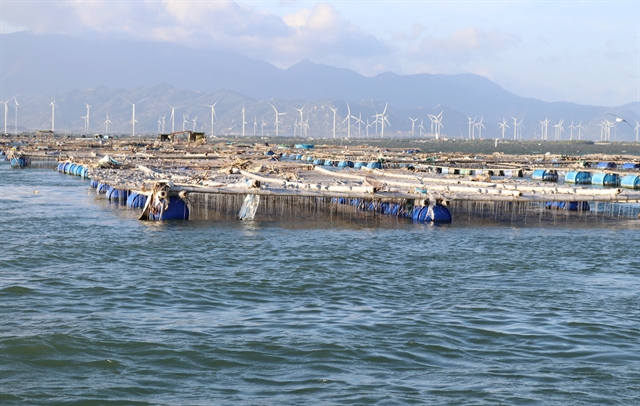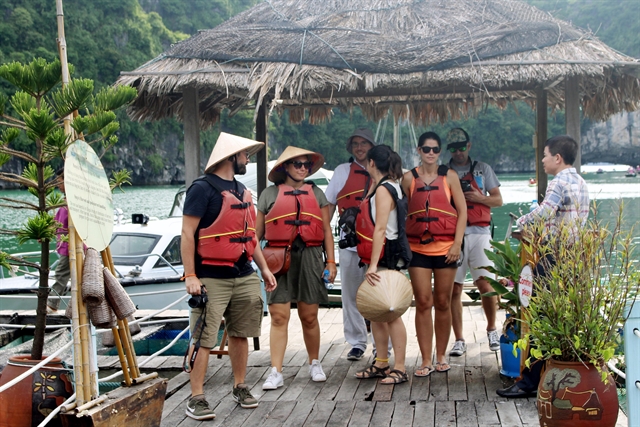 Society
Society

 |
| A marine aquaculture farm in Hòn Nghệ Commune, Kiên Lương District, Kiên Giang Province. — VNA/VNS Photo Hồng Đạt |
HÀ NỘI — The combination of marine aquaculture and tourism is an increasing trend worldwide, particularly in countries with marine advantages like Việt Nam.
Models that promote the combination have become increasingly popular in Việt Nam and are considered an effective solution to preserving marine resources, mitigating bad impacts on the ecosystem and protecting maritime sovereignty.
However, there remain bottlenecks and challenges for the implementation of such models.
Nguyễn Thị Hải Bình, director General of Super Trường Phát Plastics Group, said that some popular models combine marine agriculture and tourism, giving tourists a chance to explore authentic local activities and marine farming establishments; training tourism that offers tourists opportunities to exchange, learn new models and technologies in marine farming; and high-class resort tourism that focuses towards the development of resorts, bungalows and restaurants on the sea.
Grasping this trend, the group was deploying infrastructure for aquaculture from sustainable green materials such as HDPE and composite in coastal provinces and cities like Quảng Ninh, Hải Phòng, Khánh Hòa, Kiên Giang and Ninh Thuận.
The infrastructure made with this material is especially environmentally friendly, with a lifespan of up to 30-50 years, depending on the material and farming area.
The material is used to build aquaculture farms that also serve tourism purposes.
As a pioneering model in Việt Nam combining marine aquaculture and tourism, the group's farm in Phất Cờ Island, Vân Đồn District in Quảng Ninh Province meets strict criteria on product quality, safety, hygiene and environment.
The farm also facilitates scientific research and development to take advantage of marine resources effectively. At the same time, it properly protects the marine environment, Bình said, adding that the farm could offer a great experience for any visitors.
Associate Professor, Dr Võ Sĩ Tuấn from the Institute of Oceanography, Việt Nam Academy of Science and Technology, said that tourism was the development orientation of many coastal localities.
"Over the past years, sea tourism is the main industry that brings localities many achievements, especially in developing high-class resorts, organising various types of exploration and entertainment on the sea and in the sea," Tuấn said, adding that the orientation of tourism port development was also coming into practice.
However, the development of tourism infrastructure along the coast and on the island was increasing sedimentation, which degrades the marine environment, Tuấn said.
"Along with several uncontrolled activities, tourism has contributed to the destruction of the landscape of terrestrial and aquatic habitats, especially coral reefs - a special tourist resource of many southern localities," he said.
"Tourism is also competing with fishing, aquaculture and in conflict with marine conservation," he said, emphasising that planning for marine tourism should be carried out from an interdisciplinary perspective.
"Tourism space needs to be linked with marine conservation to exploit the resources that nature endows effectively. The resources are also the foundation for preserving the distinctiveness and supporting eco-tourism to serve high-class tourists."
"Tourism combined with high-tech marine aquaculture will be the direction to create new types of entertainment such as exploring technology or sport fishing."
In addition, Tuấn said that natural farming of expensive seafood species can be developed in the waters managed by tourism businesses.
 |
| Tourists visit the aquaculture-tourism business in Vung Viêng, Quảng Ninh Province. — VNA/VNS Photo |
Bottlenecks
Bình from Trường Phát Group said that the process of technological transformation in aquaculture and marine aquaculture, in combination with tourism, faced difficulties and obstacles.
For example, difficulties in getting licensing to use sea areas because of improper coordination among agencies responsible for management and decentralisation.
In addition, some policies on fisheries development do not have content to support marine aquaculture and have not established a legal basis for the participation of banking and insurance units.
Bình proposed the Government and local authorities set up industrial clusters for marine aquaculture.
Further communication was also needed to help seafood farmers realise the need to convert to industrial methods and scale to increase the output and quality of farmed products and protect the environment.
Localities also need focused communication programmes to develop aquaculture and tourism simultaneously, Bình said.
Associate Professor Dr Nguyễn Hữu Dũng, Chairman of the Việt Nam Association of Marine Aquaculture, said that the lack of planning, complicated procedures for allocating sea areas to organisations/fishermen, the lack of marine aquaculture-relating standards were among major bottlenecks now for the marine aquaculture industry.
Additionally, so far, there has yet to be a State agency responsible for the registration of marine farming facilities and means. There needs to be a human resource training programme for the marine aquaculture industry.
According to the Law on Fisheries, aquaculture projects must be located in the planned area for marine aquaculture planning. In addition, the Law on Planning, effective from January 1, 2019, requires the adjustment and integration of previously approved plans into the new planning system.
However, most new plans relating to aquaculture development have not been formulated and approved, making it difficult to implement the Law on Fisheries, Dũng said.
The National Marine Spatial Plan has yet to be approved nationally. Most provincial plans are being developed and have yet to be approved, so there is no basis for clearly defining the area where marine aquaculture can be developed.
"Without planning, assigning specific marine areas to farmers is impossible. This is the biggest obstacle hindering the development of the marine aquaculture industry, causing frustration for the business community and fishermen, and confusing State management agencies in coastal localities," Dũng said.
As for the trouble in allocating sea areas, currently, the procedures for assigning specific sea areas to organisations/ individuals for long-term use for marine aquaculture (maximum 30 years, can be extended for 20 years) consists of two steps implemented by two State agencies.
The Ministry of Agriculture and Rural Development grants the licence to develop sea aquaculture. Meanwhile, the Ministry of Natural Resources and Environment allocates marine areas to organisations/individuals for doing marine aquaculture.
This requires a lot of overlapping documents and procedures, causing inconvenience and being time-consuming for organisations and individuals.
According to Dũng, the Ministry of Agriculture and Rural Development drafted a decree to replace Decree 67/2014/NĐ-CP on national aquaculture development. The new decree is expected to add support policies for marine aquaculture, particularly for those who use environmentally friendly materials to make fishing cages.
In addition, more support in breeding and insurance is also expected.
Dũng said that supports for co-operatives and marine aquaculture growers were also important because they produced the highest amount of marine products. — VNS




